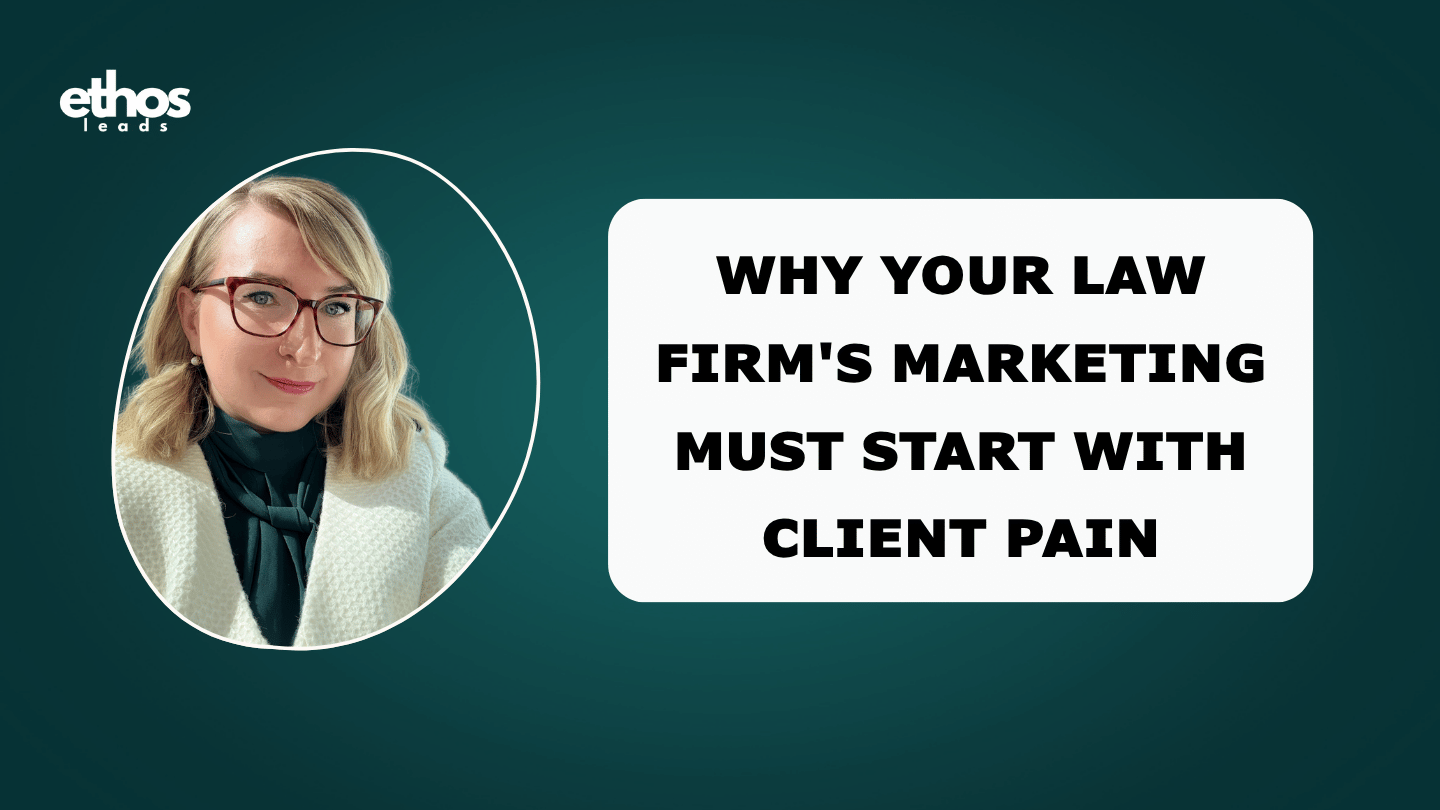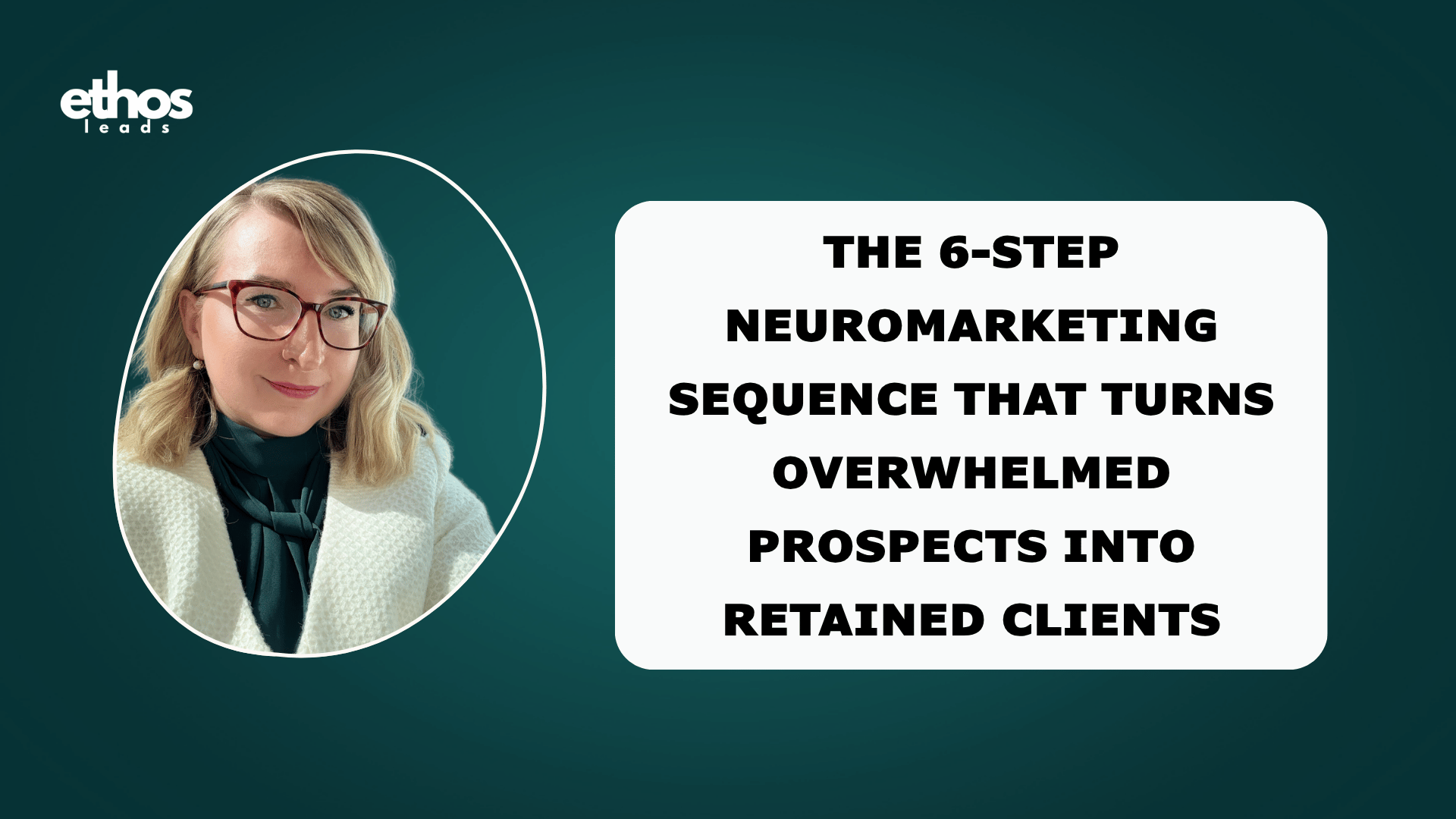Why Your Law Firm's Marketing Must Start With Client Pain
Stop Asking What Clients Want. Start Diagnosing What They Fear.
If you're a solo practitioner or small to mid-sized law firm owner, you've likely written your marketing messages around what makes your firm great: your credentials, your years of experience, your client-centered approach, or your competitive rates.
But here's what neuromarketing research reveals: your prospective clients don't buy based on what they like or want. They buy based on what they fear and what causes them pain.
Understanding this fundamental truth about human decision-making could transform how you attract and convert clients.
Why Pain Drives Your Clients’ Decisions
Most solo and small-firm lawyers believe clients hire them to get something: a win, a contract, a resolution, or a result. But neuroscience reveals a different truth. Clients hire you to avoid something. Pain, not pleasure, is what drives nearly every legal decision.
According to The Persuasion Code by Christophe Morin and Patrick Renvoise, your clients’ brains are hardwired to eliminate threats first and seek rewards second. The primal brain constantly scans for danger. When clients choose a lawyer, they’re not chasing dreams; they’re escaping fear: the fear of losing money, of making a mistake, of being judged, or of future regret.
Understanding that your audience’s “buy button” is triggered by pain avoidance is the secret to building trust and conversion without manipulation or “salesy” tactics.
The Primal Brain Makes the Decision to Hire You
Neuroscience research has uncovered something remarkable about how people make purchasing decisions, including the decision to hire an attorney. We use the same neural networks to evaluate hiring a lawyer as we use to cope with life-threatening situations. This is because decision-making is dominated by the primal brain, the ancient part of our brain wired for survival.
Your primal brain has one primary job: keep you alive and safe. It does this by constantly scanning for threats, fears, and risks that need to be eliminated. When a potential client considers hiring your firm, their primal brain isn't asking "Do I like this lawyer?" It's asking "Can this lawyer eliminate my fear and pain?"
When someone searches for a lawyer, their primal brain is in overdrive. They’re confronting risk, uncertainty, and emotional distress. They might be thinking:
- “What if I pick the wrong lawyer?”
- “What if this gets worse?”
- “What if I can’t afford to fix it?”
These aren’t abstract thoughts. They’re survival fears. The primal brain responds most strongly to messages that eliminate threats or pain. That means your marketing must start with empathy for pain, not a list of services.
How Fear Activates Decision-Making
Think of buying behavior as an iceberg. At the surface, visible and easy to articulate, are the things people say they like and want. Below the waterline, often completely unconscious, are the fears and pains that truly drive their decisions.
The human decision-making process resembles an iceberg:
- Below the surface (Unconscious Fears): Regret, rejection, risk, loss, and shame.
- Middle layer (Conscious Frustrations): Overwhelm, confusion, time pressure, uncertainty.
- Above the surface (Stated Wants): “I need help with this contract,” or “I want to file this claim.”
Traditional marketing focuses on the top: what people say they want. You tell prospects what services you offer and what makes you different, hoping they'll "want" to work with you.
But neuromarketing studies have proven that what people say they like or want are poor predictors of buying behavior. Likes and wants shift with moods, trends, and circumstances. They're vague conscious interpretations of deeper needs.
The real decision drivers live beneath the surface: fears of devastating consequences, frustrations that cause pain, and the fundamental anxiety about safety and survival. These are permanent and powerful. They're what actually make someone pick up the phone and call your firm.
The process always begins in fear. Clients start in a state of anxiety or ignorance, unsure of what to do but aware that something could go wrong. When your message connects that fear to a real consequence (regret, loss, disappointment), the primal brain awakens.
This triggers a shift from fear to anticipation, a moment when the cognitive brain (your client’s logical side) begins to justify action. At this stage, your messaging should offer not just results but relief.
Example:
Instead of saying, “We help you win your case,” try “We protect you from costly mistakes that could set you back years.”
You’ve transformed your service from a desire into a necessity.
Diagnosing the Real Pain Behind Every Legal Decision
Every potential client experiences pain in one or more of three categories, and understanding these is critical for solo lawyers and small firms:
- Financial Pain
This is the most visible and measurable pain. For your clients, financial pain might include:
- Fear of losing everything in a lawsuit
- Anxiety about mounting legal fees with no resolution in sight
- Worry about bad financial outcomes from a divorce or business dispute
- Concern about leaving money on the table in a transaction
- Strategic Pain
These are the business and life risks that could compromise someone's future. For clients, strategic pain includes:
- Fear that poor legal representation will result in a devastating loss
- Anxiety about legal problems derailing business growth or operations
- Worry that inefficient legal processes are creating compliance risks
- Concern that lack of proper legal planning leaves them vulnerable
- Personal Pain
This is where the emotional and psychological impact lives. Personal pain for clients includes:
- Elevated stress and sleepless nights over legal uncertainty
- Fear of embarrassment or damaged reputation
- Anxiety about losing custody or being treated unfairly
- Feeling overwhelmed and not knowing where to turn
Your job as a lawyer isn’t just to “solve problems.” It’s to name the pains your clients can’t articulate because often, they don’t know them consciously.
Why This Matters for Your Law Firm Marketing
Here's the critical insight: when you diagnose and speak directly to these pains in your marketing, you activate the primal brain. You move prospects from a state of anxiety and ignorance (high risk, low engagement) to a state of urgency and motivation (high engagement, ready to act).
For example, imagine two divorce attorney websites:
Attorney A: "I provide compassionate, client-centered divorce representation with 15 years of experience."
Attorney B: "Worried you'll lose time with your children? Anxious about your financial security after divorce? Stressed about facing this battle alone? I eliminate the uncertainty and protect what matters most to you."
Attorney B's message activates specific fears and pains. It makes the value proposition relevant and urgent by reawakening the pains that are already keeping the prospect up at night. That prospect's brain releases dopamine in anticipation of relief, creating the motivation to buy.
How to Diagnose Your Clients' Top Pains
The most effective way to identify the critical pains you can eliminate is surprisingly simple: have intimate dialogues with your current and past clients. Not prospects, but actual clients who have experienced your services.
Clients who have worked with you have the benefit of hindsight. They can articulate the transformation your services brought to their lives by eliminating specific pains. This information is gold for your marketing.
The Pain Dialogue: a 15-minute client interview that writes your copy
Stop guessing. Ask five of your best current clients these questions. Record, transcribe, and highlight exact phrases.
- Before we worked together, what kept you up at night about this issue?
- If you had chosen the wrong lawyer or done nothing, what did you fear would happen next?
- When did it become urgent to act, and why then?
- What almost stopped you from hiring any lawyer at all?
- What changed after our first 30 days that made you feel safer?
- What would you tell a friend who is hesitating to get help?
- What result or safeguard mattered most to you in hindsight?
What to listen for: references to regret, disappointment, cost of delay, loss of control, embarrassment, and “I just wanted to avoid…” These are your primal drivers. Likes and wants can be noted, but pains get top billing.
Putting Pain-Driven Marketing Into Practice
Once you've diagnosed the top pains your firm eliminates, make them central to your marketing messages:
- Your website homepage should immediately acknowledge the top pains your ideal clients experience
- Your consultation forms should ask prospects about their fears and frustrations, not just the facts of their case
- Your initial consultations should focus on deeply understanding pain points before discussing your services
- Your content marketing should address fears and provide reassurance, not just showcase expertise
- Your value proposition should clearly articulate which specific pains you eliminate
Remember: nothing is more powerful than asking people what they fear. What they fear comes from our human nature of being anxious and vigilant to survive.
Legal Ethics
- Name risks factually. Do not exploit fear, fabricate urgency, or guarantee outcomes.
- Prove competence with process, responsiveness, and past client experience, not promises.
- Keep everything transparent, respectful, and compliant. That is the ethos we teach and practice.
The Bottom Line for Solo Lawyers and Small Firms
You don't need a massive marketing budget to compete with larger firms. You need clarity about the pains you eliminate and the courage to speak directly to them in your marketing.
Know the pains you need to eliminate, and you have the script of your best selling arguments. Diagnose pain as your central persuasion strategy, and you'll increase the likelihood of creating marketing messages that actually convert.
Your prospective clients are already experiencing fear and pain. That's why they're looking for a lawyer. Your job isn't to convince them they should want your services. Your job is to demonstrate that you understand their pain and can eliminate it.
When you get this right, you stop chasing clients. They come to you, ready to hire, because you've spoken directly to the primal brain's most urgent need: eliminating fear and finding safety.
Related Articles:
Neuromarketing for Lawyers: An Ethical and Practical Guide for Solo and Small Law Firms
Neuromarketing for Lawyers: Personal Stimuli
How Personal Stimuli Convert More Clients
Neuromarketing for Lawyers: Contrastable Stimuli
Neuromarketing for Lawyers: Tangible Stimuli
Neuromarketing for Lawyers: Memorable Stimuli
Neuromarketing for Lawyers: Visual Stimuli
Neuromarketing for Lawyers: Emotional Stimuli
Neuromarketing for Lawyers: Integrating the Six Stimuli




